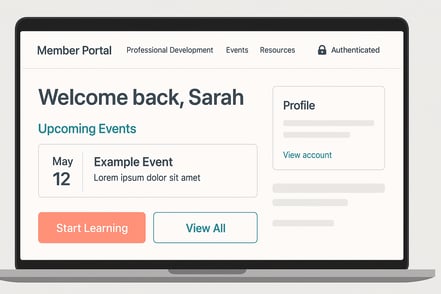This blog is based on insights from Bryan Kelly, UX strategist and content design leader, who will deliver a keynote on this topic at digitalNow 2025 (November 2-5 in Chicago). Listen to the full episode of the Sidecar Sync Podcast here.
Two massive trends are reshaping how associations serve their members. One dominates every conference agenda and strategic planning session. The other is happening quietly beneath the surface, attracting far less attention despite being more certain.
AI is everywhere. The longevity economy—the demographic shift toward adults over 50—is just as significant but far less discussed. By 2030, one-third of Americans will be over 50. That's 132 million people driving $8 trillion in annual economic activity.
Bryan Kelly's argument is straightforward: smart organizations won't treat these as separate trends. They'll design for both. The convergence is where the real opportunity lives, but also where the risks hide.
Beyond Separate Strategies
AI has captured the attention of association leaders for good reason. The technology promises to transform member experiences, automate tedious processes, and unlock insights buried in data. Every conference features AI sessions. Every strategic plan now includes AI initiatives.
The longevity economy gets less airtime. Yet it represents (perhaps) a more certain shift than anything happening with AI. The demographic data is clear. The economic power is measurable. The timeline is fixed. Within five years, adults over 50 will be the dominant demographic.
These aren't competing priorities. They're converging forces that will reshape member expectations and organizational capabilities simultaneously. Organizations that understand both trends will have significant competitive advantage. Those that focus exclusively on AI while ignoring the demographic shift—or vice versa—will miss opportunities that only exist at the intersection.
The risk of treating these separately is real. You might build sophisticated AI-powered member experiences that completely miss the mark for your largest demographic segment. Or you might develop excellent programs for members over 50 but lack the infrastructure to deliver personalized experiences at scale.
The Promise of AI for Personalized Member Experience
The dream scenario for associations involves AI creating truly personalized member experiences in real-time based on psychographic data and behavior patterns.
Imagine a member logging into your portal and seeing content, learning paths, and opportunities tailored specifically to their life stage, professional goals, and interests. Not based on crude demographic segments, but on nuanced understanding of who they are and what they need right now.
AI could make this possible at scale. The technology can:
- Analyze behavior patterns across thousands of members to identify meaningful segments
- Tailor content and recommendations to individual preferences
- Adjust learning paths based on progress and engagement
- Surface relevant connections and opportunities without manual curation
- Optimize experiences continuously based on what's working
This matters especially for the longevity economy because the 50+ demographic is remarkably diverse. A 52-year-old and a 68-year-old might have completely different needs. Two 62-year-olds in different life stages might have more differences than similarities. The one-size-fits-all approach fails here more dramatically than with any other segment.
AI offers a way to serve this diversity without requiring armies of staff to manually customize everything. You can deliver experiences that feel personal and relevant to individuals within a massive, heterogeneous group.
The technology exists, but implementation at the level of sophistication needed remains uncommon. The trajectory is promising though, and associations that start building toward this vision now will be positioned well as capabilities mature.
The Hidden Problem: AI's Age Bias
Here's where Kelly drops the warning that should make every association leader pause.
AI systems have been trained on age-biased content. When you ask AI to help build strategy for members over 50, you often get output that reinforces exactly the stereotypes and assumptions you should be avoiding.
Kelly tested this across multiple AI tools—Claude, ChatGPT, Gemini. The results were consistently problematic. The AI made assumptions about capability, needs, and preferences that reflected decades of ageist stereotypes baked into the training data.
Examples of what this looks like:
- Assumptions that older users need simplified interfaces
- Language that talks down or over-explains basic concepts
- Recommendations that treat age as the primary factor rather than behavior or life stage
- Personas that rely on outdated stereotypes about retirement and leisure
- Strategy suggestions that ignore the diversity within the demographic
The irony is sharp. You might turn to AI to help you better serve your 50+ members, only to have the technology reinforce the exact biases that have made this demographic underserved in the first place.
This happens because AI learns from existing content, and existing content is full of age bias. Marketing materials, product descriptions, research studies, articles—much of what's been published about older adults reflects assumptions rather than reality. The AI absorbs those assumptions and reproduces them in its output.
Kelly calls age bias the last socially acceptable form of discrimination. People who would never make sweeping generalizations about other demographics feel comfortable making them about older adults. Those generalizations have saturated the content AI trains on.
Working Around the Bias
Kelly's solution was to build a custom GPT trained specifically on research from credible sources: MIT Age Lab, Stanford Center for Longevity, AARP studies. He fed it evidence-based research rather than letting it rely on general training data.
Even with a specialized model, he needs to prompt carefully and review output critically. He'll ask the AI to generate content, then prompt it to review that content for age bias. The bias-checking step often reveals problems that weren't obvious initially.
The lesson isn't that you can't use AI for work involving the longevity economy. The lesson is that you can't use it naively. You need:
Human oversight. AI can accelerate work and surface patterns, but humans need to review output for bias and stereotyping.
Specific training data. If you're building AI tools for this demographic, train them on quality research rather than general web content.
Critical prompting. Ask AI to check its own output for ageist assumptions. Build bias review into your workflow.
Member testing. Before deploying AI-generated content or strategies, test them with actual members over 50. Their feedback will reveal problems faster than any internal review.
Team education. Train your team to recognize age bias in both human and AI-generated content. It's pervasive enough that even well-intentioned people miss it.
This isn't a reason to avoid AI. It's a reason to be strategic and thoughtful about how you use it.
Designing for the Convergence
What does it actually look like to design for both AI and the longevity economy simultaneously?
It starts with using AI as a tool rather than a decision-maker. AI can help you analyze patterns, personalize experiences, and operate efficiently at scale. But the strategic decisions about what matters to members and how to serve them need human judgment informed by research.
Ground AI-assisted personalization in actual research with 50+ members. Don't let AI create personas or strategies in a vacuum. Use it to enhance and scale insights you've gathered through real conversations with real members.
Focus on behavior and psychographics—areas where AI can genuinely help identify patterns—rather than age demographics. AI can analyze thousands of member interactions to understand what motivates different groups. It can spot life stage patterns that would take humans months to recognize manually. Let it do that work while you maintain focus on what actually matters.
Build systems that deliver clarity, trust, and security at scale. These are the three things members over 50 value most in digital experiences. AI can help you deliver them consistently across thousands of touchpoints, but only if you've defined what they look like in your context first.
Leverage AI for efficiency while maintaining the human judgment needed to avoid bias. The goal is augmentation, not replacement. AI handles scale and pattern recognition. Humans handle strategy, empathy, and quality control.
Organizations that figure this out will deliver member experiences that feel both personalized and respectful. Members will receive content and opportunities tailored to their actual needs rather than age-based assumptions. They'll encounter digital experiences that work well without being patronizing. They'll feel understood as individuals rather than lumped into a crude demographic bucket.
This is harder than focusing on just one trend. It requires understanding both AI capabilities and longevity economy research. It demands thoughtful implementation rather than quick wins. The payoff is significant for organizations willing to do the work.
Where to Start
If you're already using AI for member strategy, persona development, or content personalization, start by auditing the output for age bias. Look for assumptions about capability, preferences, and needs based on age rather than behavior.
Test AI-generated content with actual members over 50 before wide deployment. Their feedback will reveal whether your AI is serving them well or reinforcing stereotypes.
Build review processes that specifically look for stereotyping. Make bias checking a standard step in any AI-assisted workflow involving this demographic.
Invest time in understanding longevity economy research. MIT Age Lab, Stanford Center for Longevity, and AARP all publish evidence-based studies about adults over 50. This research should inform your strategy whether you're using AI or not.
Train your team to recognize age bias in content. It shows up in subtle ways—language choices, assumptions about technology comfort, over-explanation of basic concepts. The more people on your team who can spot it, the less likely it is to reach members.
Consider the longevity economy in your AI implementation plans from the beginning. Don't treat these as separate workstreams where you implement AI first and figure out the demographic implications later. Build integrated strategies that account for both from the start.
The Path Forward
Both trends are here. Both are accelerating. AI gets the headlines and the budget conversations. The longevity economy is the more certain shift, happening on a fixed timeline with measurable economic impact.
The real opportunity is in the convergence. Using AI thoughtfully to serve a demographic that's been consistently underserved requires vigilance about bias while remaining open to possibility. It requires patience with imperfect technology while pushing for better implementation.
The associations that navigate this convergence well will have major competitive advantage. They'll deliver personalized experiences at scale to their largest and most economically powerful demographic segment. They'll use AI to enhance rather than replace human judgment. They'll serve members over 50 in ways that feel respectful, relevant, and genuinely helpful.
That's the vision worth working toward. It won't happen automatically, and it won't happen by focusing on just one trend while ignoring the other. But for organizations willing to design intentionally for both, the opportunity is substantial.
To hear the full conversation with Bryan Kelly about AI, the longevity economy, and designing better member experiences, listen to the complete episode of the Sidecar Sync Podcast. Bryan will be delivering a keynote on this topic at digitalNow, November 2-5, 2025 in Chicago.

October 29, 2025

